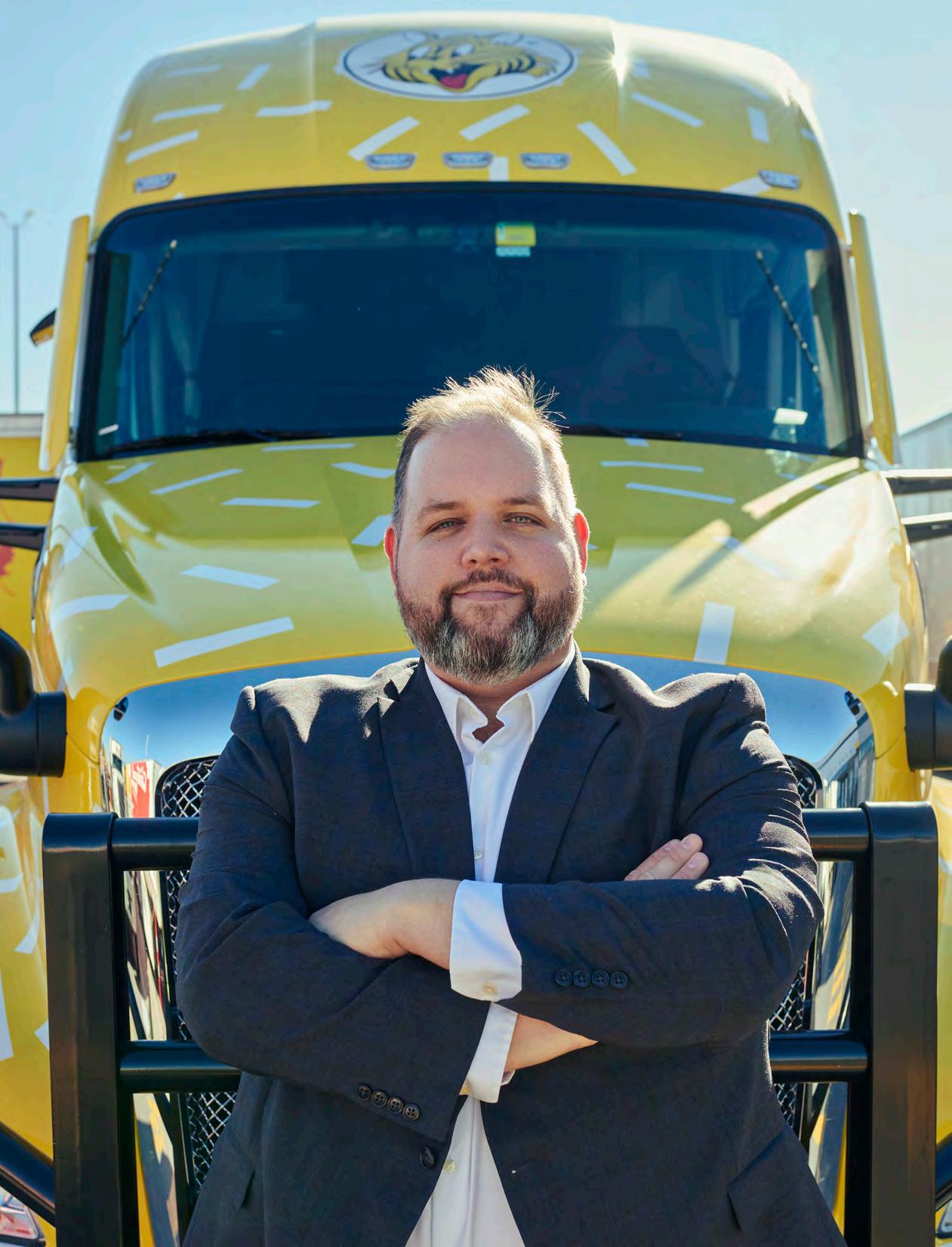
Publication mail agreement #43734062 INSIDELOGISTICS.CA CANADA’S SUPPLY CHAIN MAGAZINE NOW INCLUDING: Canadian Shipper DECEMBER 2022 › Transportation buying trends › Nearshoring or friendshoring? › Visibility through intermodal moves Turnkey Media Solutions Inc. 48 Lumsden Crescent, Whitby, Ontario, Canada L1R 1G5 A GIANT SUCCESS STORY Giant Tiger’s James Johnstone is Supply Chain Executive of the Year





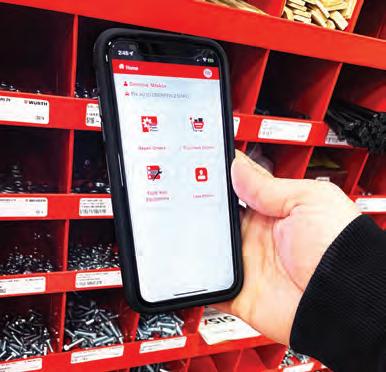
your inventory management to the
Take
next level
connect
KANBAN light mobil
mat






insidelogistics.ca 3 In every issue: 5 Taking Stock EV readiness 6 Supply Chain Scan News and numbers from around the world 11 Movers + Shakers Appointments and promotions 29 Trade Update Trading with India 30 Safety First Preventing head injuries CONTENT S 16 Executive of the Year How James Johnstone has transformed transportation at Giant Tiger 24 Nearshoring The economics of bringing production and supply closer to home 27 Rail How to gain visibility into your intermodal moves 6 ON THE COVER | PAGE 14 SUPP LY CHAIN SCAN DHL buys Canadian-made EVs | Air Canada invests in decarbonization | X-ray enabled pre-clearance | Logistics awards | Climate fund DECEMBER 20 22 • VOLUME 67 • NUMBER 05 CANAD A ’S SUPP L Y CHAIN MAGAZIN E NOW INCORPORATING CANADIAN SHIPPER 16 27 24 Buying trends What transportation will cost next year 20 image: ImagineDesign/AdobeStock image: Travel mania /AdobeStock image: panyajampatong /AdobeStock


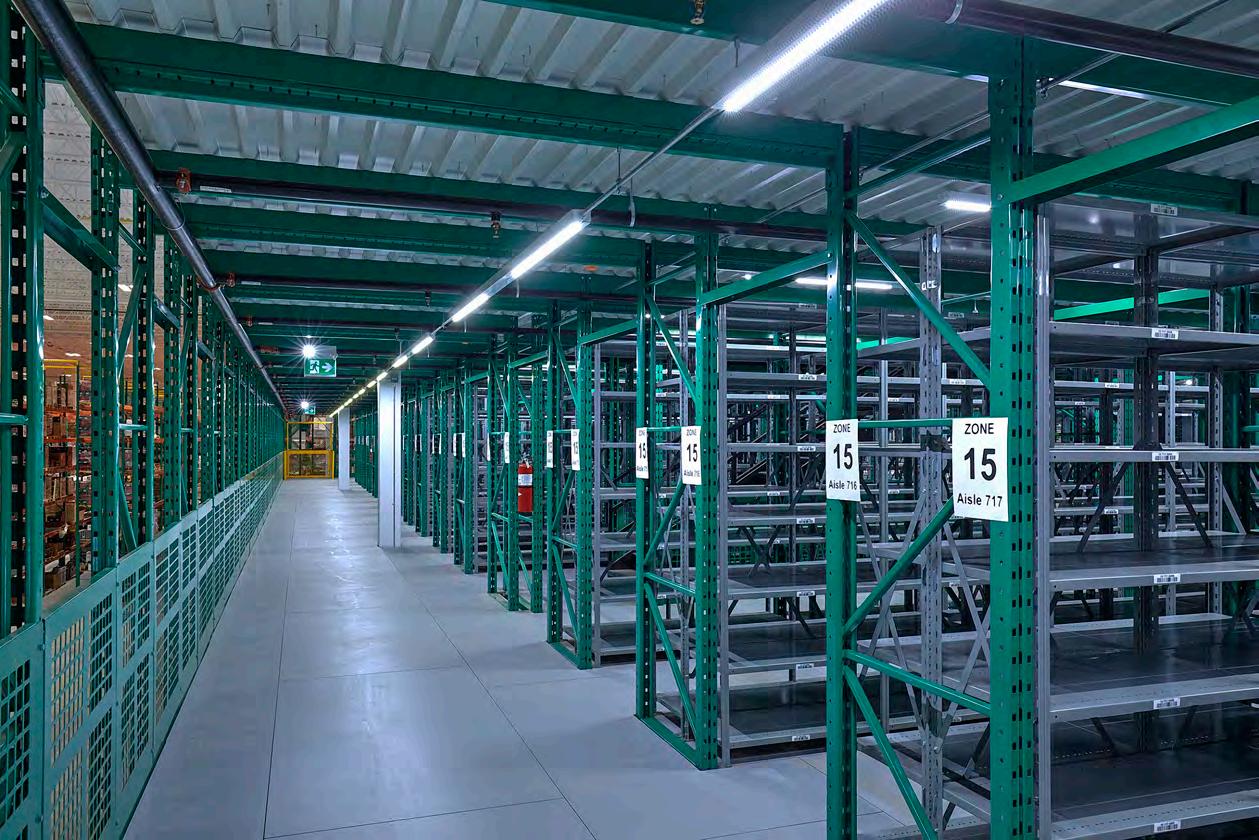
Listen Plan Design Integrate PALLET RACKING DRIVE-IN PUSHBACK MEZZANINES PALLET FLOW CANTILEVER CARTON FLOW SHELVING 3D STORAGE SOLUTION S L IMIT ED 1 (877) 557-2257
Publisher | Delon Rashid (416) 459-0063 delon@turnkey.media
Editor | Emily Atkins (416) 262-4106 emily@turnkey.media

Contributing Writers | Andy Adams, Thomas Cook, Norm Kramer, Christian Sivière, Toni Volpato

Creative Director | Samantha Jackson
Video / Audio Engineer | Ashley Mikalauskas, Nicholas Paddison
Sales | Delon Rashid, (416) 459-0063 delon@turnkey.media Peter Bulmer, (585) 653-6768 peter@turnkey.media
Production and Ad-ops | Tracy Stone tracy@turnkey.media

Inside Logistics magazine is published by Turnkey Media Solutions Inc. All rights reserved. Printed in Canada. The contents of this publication may not be reproduced or transmitted in any form, either in part or full, including photocopying and recording, without the written consent of the copyright owner. Nor may any part of this publication be stored in a retrieval system of any nature without prior consent.

Canada Post Canadian Publications Mail Sales Product Agreement No. 43734062


“Return Postage Guaranteed” Send change of address notices, undeliverable copies and subscription orders to: Circulation Dept., Inside Logistics magazine, 48 Lumsden Crescent, Whitby, ON, L1R 1G5
Inside Logistics magazine (ISSN No.: 0025-5343 (Print); 1929-6460 (Digital) is published six times per year by Turnkey Media Solutions Inc., 48 Lumsden Crescent, Whitby, ON, L1R 1G5
From time to time we make our subscription list available to select companies and organizations whose product or service may interest you. If you do not wish your contact information to be made available, please contact us.
Are EVs the future? Part 2
A COUPLE ISSUES AGO I wrote about the infrastructure challenges facing companies wanting to adopt electric vehicles into their delivery fleets. I suggested that we are not quite ready for full adoption thanks to the cost of bringing sufficient power supply to existing depots and distribution centres, as well as the as-yet-unsolved challenges of cold-weather operation. The typical EV still loses about 25 percent of its range in cold temperatures.
Nonetheless, it’s extremely good news that Canada’s first full-scale electric vehicle assembly plant has begun production. I was lucky to be able to attend the official opening of GM subsidiary BrightDrop’s new facility in Ingersoll, Ontario on December 5th. It is the old GM Cami plant that until April this year was making the Chevrolet Equinox SUV.
Now it’s been retooled – in the fastest plant conversion in its history, GM says, to produce the Zevo 600 fully electric delivery van. The plant is automated and poised for growth. Full production is slated to begin in January 2023, and a second vehicle – the smaller Zevo 400, will be added to its repertoire later next year. Inside Logistics will have more on the plant and how the retooling went in a future edition.
Perhaps more exciting than the $1.5 billion plant itself was the announcement that DHL Express Canada is the first Canadian customer for the Zevo 600. In addition to be a show of support for a made-in-Canada product, this signals a strong commitment from a northern operator to the concept of EV-powered last-mile delivery. And they’re probably not alone. Other Canadian courier companies were in attendance at the BrightDrop plant opening, and were overheard expressing a strong interest in the vans.
I’m really interested to see how these last-mile delivery companies integrate volumes of EVS into the Canadian space. So far their use has been limited to pilot projects or small scale implementations. But with the federal purchase incentives announced this past summer, I expect there will be more and more basis for assessment of how they do in real-world conditions. (Interestingly, the Zevo 600 is not currently on the list of eligible EVs.)
If your company is considering EVs for your fleet, please drop me a note. I’d be interested in finding a couple operators who’d share their experiences.
Corporate Office 48 Lumsden Crescent, Whitby, ON, L1R 1G5
With that, I’d like to wish everyone a happy and healthful new year, and every business success in 2023.
ISSN 0025-5343 Online 1929-6460
insidelogistics.ca 5
TAKING STOCK
BRIGHTDROP OPENING –PAGE 6.
President & Managing Partner | Delon Rashid Head of Sales & Managing Partner | Peter Bulmer
X-RAY TRIAL
BrightDrop vans roll off the line in Ontario
ELECTRIC DELIVERY VANS made by GM subsidiary BrightDrop have begun to roll off the line in Ingersoll, Ontario.
At an official opening event on December 5 attended by prime minister Justin Trudeau and Ontario premier Doug Ford, GM and BrightDrop celebrated the reopening of GM's Cami plant, which has been retooled to make the EVs.
“Electric-vehicle manufacturing in Canada is no longer something that’s happening in the future. It’s here and it’s now. That’s good for Canada, and good for the planet,” said GM Canada president Marissa West.
The company also announced that DHL Express Canada will be its first Canadian customer. While the number of vans DHL has ordered was not disclosed, BrightDrop has already produced 155 Zevo 600s for its launch customer, FedEx. Most of those vans were delivered in the Spring of 2022, and are on the road in the US.

GM says the retooling of the Cami plant was the fastest in its history. Production on the Chevrolet Equinox SUV, which had been built at Cami since 2017, was halted in April 2022. The retooling began on May 1, and the first Zevo 600 rolled off the line in the final week of November, just seven months later.
GM spent $1 billion on the reconfiguration of the assembly facility, helped by contributions of $250 million from both the federal and provincial governments.
At the event, premier Ford called the plant a "made in Ontario" success story. He said the plant is the first step in Ontario returning to being a global vehicle manufacturing centre.
GM's strategy in developing the BrightDrop spinoff was to take advantage of the "greenspace" in the electric delivery sector, said Steven Hornylak, BrightDrop's chief commercial officer in an interview. The gambit appears to be taking off, as BrightDrop now has more than 25,000 orders and commitments from FedEx and DHL Canada along with giants like Walmart, Hertz, and Verizon.
Hornylak said that with the opening of the Cami plant, BrightDrop has more than enough capacity to meet its orders several times over. Full production is slated to begin in January, with a second shift to be added early in the year. The company currently has 400 workers trained on the highly automated line, and says it will be hiring another 1,200 in the coming year.
BrightDrop offers a suite of products including the Zevo vans, the Trace eCarts, and the BrightDrop Core software platform. A smaller Zevo 400 will be introduced next year.
6 INSIDE Logistics DECEMBER 20 22
Success for CBSA and UPS preclearance pilot project 8 CUTTING CO 2 Transport companies lagging 10 MOVERS + SHAKERS Appointments and promotions 11 SUPPLY CHAIN SCAN |
By Emily Atkins
DHL Express Canada will be the first Canadian customer for BrightDrop's electric Zevo 600 vans.
Photo credit: Emily Atkins
Pallet inventor recognized posthumously

THE LOGISTICS HALL OF FAME has posthumously lauded The Raymond Corporation’s founder, George Raymond Sr., as an inductee for his invention of the first double-faced wooden pallet.

The organization celebrated this year’s honourees at a gala reception with German transport minister Volker Wissing on Nov. 29 in Berlin.
“It’s an honour to have our founder recognized for a pivotal innovation that changed the trajectory of the logistics industry,” said Michael Field, president and CEO of The Raymond Corporation.
“The invention of the double-faced wooden pallet centered on helping customers bring their operations to a new level of performance. Today, we continue George Raymond’s legacy by finding innovative intralogistics solutions that help customers run better and manage smarter through our lean-based approach of optimize, connect, and automate.”
Developed in the 1930s by George Raymond Sr. and his colleague, William House, the double-faced wooden pallet permits the high stacking of crushable goods. In a show of commitment to the industry, Raymond Sr. donated the patent to the industry soon after it was awarded.
“It’s incredible to see the lasting impact my grandfather had and how his spirit of innovation lives on today at The Raymond Corporation,” said Steve Raymond, retired president of Raymond Handling Concepts Corporation and grandson of Raymond’s founder.
“One hundred years later, the double-faced wooden pallet remains an industry standard, helping to transport an ever-increasing amount of goods around the globe. Thank you to the Logistics Hall of Fame for this honour."
insidelogistics.ca 7 | SUPPLY CHAIN SCAN
Raymond Corporation president and CEO Michael Field accepts the award at the Logistics Hall of Fame gala in November.
CBSA and UPS conclude X-ray trial
UPS Canada have concluded a pilot project to test a digital pre-screening process.
The Virtual Cargo Pre-Screening proof of concept, held from May to November 2022, provided an opportunity to enhance the way goods are risk assessed prior to their arrival in Canada.
For the proof of concept, UPS captured X-ray images of goods destined for Canada before they departed from Europe. The X-ray images were then transmitted to the

CBSA Border Services Officers (BSOs) prior to arrival of the goods to Canada, along with other required pre-arrival shipment data, for use in their assessment of goods.
This gave Border Services Officers earlier access to supplemental information to aid decision-making about shipments before their arrival in Canada.

The virtual cargo pre-screening process successfully demonstrated the viability of more efficient processes for goods entering Canada. It also allowed BSOs to receive additional information about shipments before their arrival.
The pilot also tested opportunities to reduce physical touchpoints for e-commerce goods to aid in managing growing volumes. As well, it evaluated the use of X-ray images to enhance the detection of goods that are non-compliant or illicit.
“UPS Canada is proud to have partnered with the CBSA on this innovative proof of concept. As global supply chains become increasingly complex, opportunities to explore new ways to leverage technology to facilitate legitimate trade are crucial,” said Tammy Bilodeau, vice-president of customs brokerage and compliance at UPS Canada.
Lessons learned from this proof of concept project will inform the development of future commercial and trade modernization initiatives and improved border processes, CBSA said.
8 INSIDE Logistics DECEMBER 20 22
THE CANADA BORDER SERVICES AGENCY (CBSA) and
SUPPLY CHAIN SCAN |
Air Canada invests in carbon capture startup

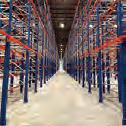
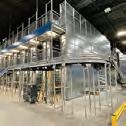
capture scalability and other initiatives for our industry. We are proud to invest in CE to further advance new, transformational technologies towards carbon removal commercially,” said Michael Rousseau, president and CEO at Air Canada.
Air Canada has committed to net-zero GHG emissions from all its global operations by 2050, with absolute mid-term GHG net reduction targets by 2030 of 20 percent from air operations and 30 percent from ground operations compared to its 2019 baseline.
AIR CANADA AND AIRBUS have announced they are investing in Canadian climate solutions company Carbon Engineering (CE).




Air Canada is making an equity investment/loan of $6.75 million, while Airbus did not disclose its level of participation.

The investment supports the advancement of CE’s Direct Air Capture (DAC) technology at the company’s research facility in Squamish, B.C.




According to CE, their process uses large fans to pull in air and then, through a series of processes, extracts the CO2 while returning the other air components to the environment. The captured atmospheric CO2 can be used to reduce aviation emissions by producing sustainable aviation fuels (SAF) that can be drop-in compatible with today’s aircraft. The captured CO2 can also be safely and durably stored in geologic reservoirs to provide carbon dioxide removals that can used to offset GHG emissions.
As the aviation industry cannot capture all CO2 emissions released into the atmosphere at source, captured atmospheric CO2 can also be safely and permanently stored in geologic reservoirs. This carbon removal solution would allow the sector to extract the equivalent amount of emissions from its operations directly from the air, thereby counterbalancing residual emissions.
Under its Climate Action Plan, Air Canada has committed to achieve net-zero GHG emissions by 2050. To help achieve this goal, the company created a $50 million investment fund to support new technologies.
The $6.75 million being invested in CE comes from this fund and follows on an earlier announcement by Air Canada that it is investing US$5 million in Heart Aerospace, a Swedish company developing electric hybrid aircraft.


“We remain focused on seeking innovative, long-term, sustainable GHG emissions reduction solutions for aviation, and carbon capture is one we have outlined in our strategy to achieving net-zero GHG emissions by 2050. Last year, we became the first Canadian airline to sign an MOU with CE to explore carbon

insidelogistics.ca 9 | SUPPLY CHAIN SCAN
Carbon Engineering is developing carbon capture technology at its base in Squamish, BC.
World's transport companies lagging on decarbonization
A NEW STUDY has found that the world's transport providers are lagging on efforts to decarbonize.
The World Benchmarking Alliance’s Transport Benchmark found that only seven percent of the companies assessed have committed to phasing out their use of fossil fuels. And half (51 percent) have set net-zero targets. Across all companies, 85 percent have fleets incompatible with a low-carbon future, but the majority fail to disclose any plans for changing this.
Transport has the highest reliance on fossil fuels of all sectors, with more than 90 percent of transport energy coming from crude oil-derived products.
The comprehensive analysis of 90 companies covers 25 airlines, nine railways, six trucking companies, 17 liner shipping providers, and 33 multimodal companies.

The research was conducted in partnership with CDP, the nonprofit that runs the world's environmental disclosure system, and assessed companies including American Airlines, Japan Airlines, Ryanair, Qatar Airways, Maersk, Royal Mail and FedEx. The research uses the Assessing low-Carbon Transition (ACT) methodology that drives climate action by benchmarking companies against advanced, science-based metrics.
The research ranked the top performing companies in relation to decarbonization. Only two in the top five provide cargo-related services. The French postal service company, La Poste Groupe, has significantly reduced its overall emissions, in part due to the electrification of the company’s fleet, which reached 38 percent in 2021. Maersk is one of the few companies with a policy to engage trade associations on climate issues, and reviews its membership status annually to ensure its trade associations are in alignment with the Paris Agreement.


Almost none of the companies (only six percent) of companies provide any meaningful data on research and development into low-carbon vehicles and fuels. Some of the solutions that transport operators need to adopt, such as alternative fuels (including ammonia, hydrogen, and sustainable aviation fuel) and cleaner vehicles (including electric trucks) are still in early development. Analysis showed that on average only 0.3 percent of total transport related revenues are invested in research and development (R&D) into low-carbon technologies and fuels, such as electric vehicles and sustainable aviation fuels.
Only three out of the 90 showed any significant support for low-carbon policy, and just six directly work with infrastructure operators to build low-carbon solutions. Almost half (48 percent) of the benchmarked companies have a strategy to help customers to reduce emissions but none of the companies had set measurable targets for customer engagement to encourage low-carbon alternatives.
“Transport accounts for 37 percent of global carbon emissions, so the sector has to step up if we are to keep 1.5 alive," said Vicky Sins, World Benchmarking Alliance’s decarbonization and energy transformation lead
10 INSIDE Logistics DECEMBER 20 22
SUPPLY CHAIN SCAN |
AUTOMATION ASSOCIATES INC. 6705 Tomken Road, Suite 211, Mississauga, Ontario L5T 2J6 905-565-6560 Bringing Discipline, Structure and Visibility to the Supply Chain www.rfpathways.com RF_P_third square.indd 1 2022-07-04 3:33 PM
Credit: Photo by Martin Magnemyr, Unsplash
movers + shakers
Michael King has joined the Nulogy leadership team as customer experience officer (CXO). In this newly created role, King will report directly to CEO Jason Tham. King's most recent role was as director with the technology solutions group at consultancy MNP. He previously worked for a decade at IndustryBuilt Software, where he was most recently VP of professional services and SVP of customer success. King holds an engineering degree from McMaster University.

Michael King
Ontario-based robotic ASRS start-up Darwynn Ltd. has appointed an advisory board. They are: Tina Dacin – Stephen J.R. Smith chaired professor of strategy and organizational behaviour, Queen’s University, Smith School of Business; Jim Defer – chief financial officer of Tribe Property Technologies; Elsie Li – CFO for Central City Brewers & Distillers, and founding partner
founder and CEO of the Strongpoint Group, former senior vice-president of operations at Indigo and previous COO of GoBolt Logistics; Amir Sahba – founder and CEO of Thinkingbox; Jim Slomka – executive vice-president at Grocery Business Magazine; Ma Song – senior vice president at JD.com, and Founder of Qiyi Technology; and Jerome Vallet – worldwide director at Kering.
Henry Canitz, Nulogy's vice-president, industry strategy, has been appointed to the board of directors of the Foundation for Supply Chain Solutions (F4SS). Founded in 2006, F4SS is a trade association focused on building and strengthening supply chain partnerships within the fast-moving consumer goods (FMCG) industry. Canitz brings more than 30 years of supply chain experience to the F4SS Board.
Consultant and independent director Richard Guay is retiring after 18 years on the board of TFI International Inc. Guay will depart Decem-
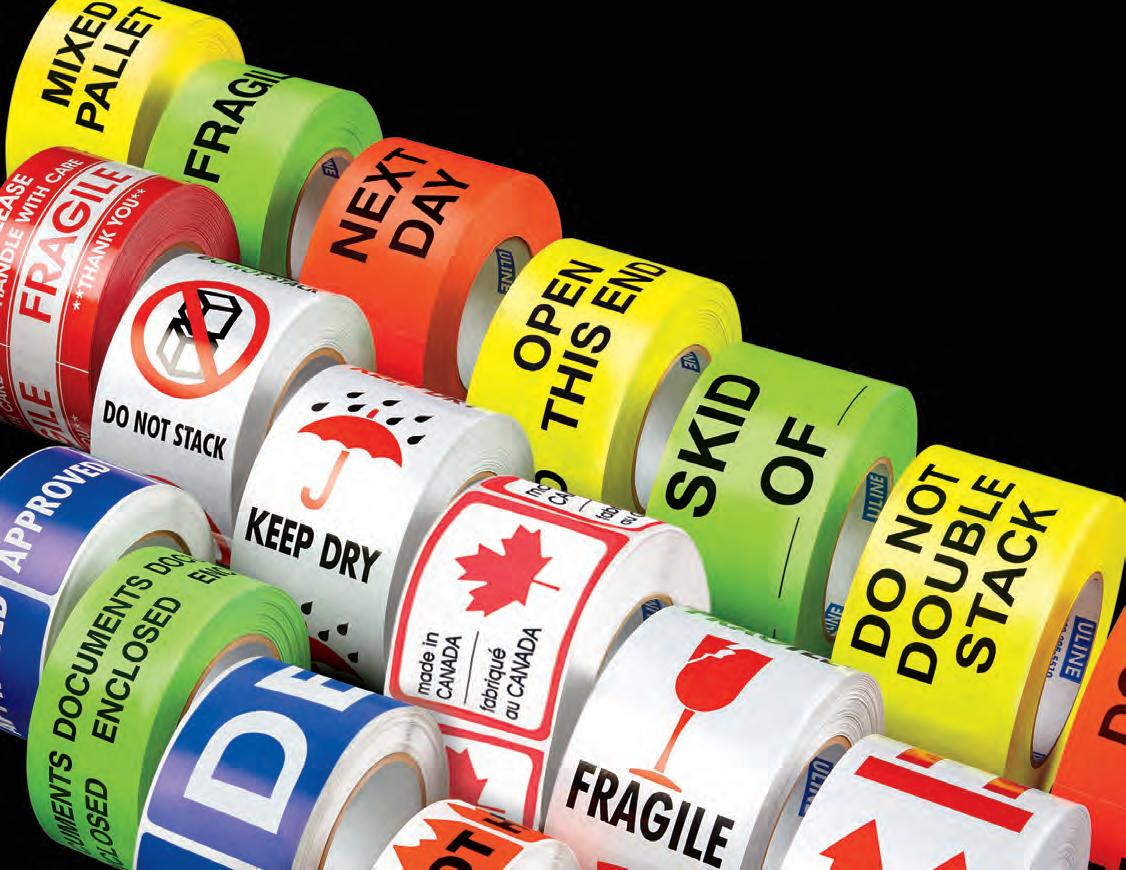
ber 31, 2022. “Since first joining our board in 2004, Richard has brought tremendous insight and passion to our decision-making process during a period of phenomenal growth,” said Alain Bédard, chairman, president and CEO.
American Airlines Cargo has appointed Greg Schwendinger president. The announcement follows the departure of Jessica Tyler. Schwendinger most recently led the finance team at AccentCare.
Ed Aldridge, president of CMA CGM America and American President Lines (APL), retired on December 6. Peter Levesque, an international global supply chain executive with more than 30 years of leadership experience, took over the presidency of both CMA CGM America and APL. Levesque was president of Ports America Group until 2021. Before that he spent 25 years in Hong Kong, where he was CEO of Modern Terminals Limited, CEVA Logistics and DHL.
| SUPPLY CHAIN SCAN 22_003847_INSIDE_Logistics_NOV_DEC_CN Mod:November4,20228:28AM Print:11/04/22 4:41:45PM page1 v7 π OVER 2,200 LABEL PRODUCTS IN STOCK ORDER BY 6 PM FOR SAME DAY SHIPPING 1-800-295-5510 uline.ca
























 Ara Asokan, CCLP Scarborough, ON Solange Bamoum, CCLP Lachine, QC
Rachel Arseneau, CCLP Mississauga, ON
Nothing says professional logistics expert like CCLP CITT is proud to present the CITT-Certified Logistics Professionals who earned their CCLP designations between September 2021 & October 2022. Congratulations to the more than 100 dedicated supply chain logistics professionals who now join the ranks of the industry’s elite.
Cole Brumwell, CCLP Mississauga, ON Matthieu Casey, CCLP Dorval, QC
Ruby Cozart, CCLP Chaplin, SK
Shady El-Orbany, CCLP Calgary, AB
Maria Luisa Espinola, CCLP Toronto, ON Katherine Evans, CCLP Cambridge, ON Adebayo Fadehan, CCLP Winnipeg, MB
Dan Granic, CCLP Mississauga, ON
James Homolka, CCLP Mississauga, ON Kobina Impraim, CCLP Milton, ON
Alan Johnstone, CCLP Toronto, ON Silvio Kusakawa, CCLP Toronto, ON
Kersti Lee, CCLP Saint John, NB
Thomas Lemierzewicz, CCLP, Oakville, ON
Clay Dowling, CCLP Saskatoon, SK
William Li, CCLP Surrey, BC
Brett Lyon, CCLP Winnipeg, MB
Chad MacGillivray, CCLP Markham, ON Karolina Mazurowski, CCLP, Surrey, BC
Glen Mol, CCLP Mississauga, ON
Patrick Nebo, CCLP Lagos
Ara Asokan, CCLP Scarborough, ON Solange Bamoum, CCLP Lachine, QC
Rachel Arseneau, CCLP Mississauga, ON
Nothing says professional logistics expert like CCLP CITT is proud to present the CITT-Certified Logistics Professionals who earned their CCLP designations between September 2021 & October 2022. Congratulations to the more than 100 dedicated supply chain logistics professionals who now join the ranks of the industry’s elite.
Cole Brumwell, CCLP Mississauga, ON Matthieu Casey, CCLP Dorval, QC
Ruby Cozart, CCLP Chaplin, SK
Shady El-Orbany, CCLP Calgary, AB
Maria Luisa Espinola, CCLP Toronto, ON Katherine Evans, CCLP Cambridge, ON Adebayo Fadehan, CCLP Winnipeg, MB
Dan Granic, CCLP Mississauga, ON
James Homolka, CCLP Mississauga, ON Kobina Impraim, CCLP Milton, ON
Alan Johnstone, CCLP Toronto, ON Silvio Kusakawa, CCLP Toronto, ON
Kersti Lee, CCLP Saint John, NB
Thomas Lemierzewicz, CCLP, Oakville, ON
Clay Dowling, CCLP Saskatoon, SK
William Li, CCLP Surrey, BC
Brett Lyon, CCLP Winnipeg, MB
Chad MacGillivray, CCLP Markham, ON Karolina Mazurowski, CCLP, Surrey, BC
Glen Mol, CCLP Mississauga, ON
Patrick Nebo, CCLP Lagos
See the List of all current CCLP designation holders at www.citt.ca/CCLPs
Learn how you can become a CCLP at citt.ca/start_now
Volodymyr Abramov, CCLP, ON Rakesh Aery, CCLP, ON Oluwatoyin Akinrelere, CCLP, ON Tyler Allan, CCLP, ON Aniella Antonio Peralta, CCLP, BC
Petra Badr, CCLP, Spain Austin Beaver, CCLP, ON Andres Betancur, CCLP, ON Tim Buschhaus, CCLP, ON Nicole Bye, CCLP, AB
Daniel Cagan, CCLP, ON Stewart Cao, CCLP, ON Julian Capogna, CCLP, ON Dominic Carabine, CCLP, ON Chris Clark, CCLP, MB


Abdul Dabbous, CCLP, Lebanon Walaa Daoud, CCLP, ON Renee Diep, CCLP, ON Oleg Dudarenko, CCLP, AB David Erazo, CCLP, ON Josh Ferguson, CCLP, AB Elsa Fréchette, CCLP, QC Hai Lan Gao, CCLP Andrew Genaille, CCLP, SK
Renu Gopinathan, CCLP, ON Umair Hameed, CCLP, ON Thomas Hennig, CCLP, ON Bonnie Hildebrand, CCLP, AB Christopher Hiltz, CCLP, QC Matthew Howells, CCLP, ON Qasim Inayat, CCLP, ON Gina Jackson, CCLP, BC
Finu John, CCLP, ON Damilola Komolafe, CCLP, ON Philippe Labbé, CCLP, NB Yi-Chieh Lee, CCLP, BC




Lauren Leshchyshyn, CCLP, SK Jason Litowitz, CCLP, MB
Devon Magnuson, CCLP, BC Salauddin Mamun, CCLP, ON Anuraj Mangat, CCLP, BC
Balaji Manivannan, CCLP, NB Antonio Mariani, CCLP, ON Aalhad Markandeya, CCLP, ON Josie McCully, CCLP, NS
Bailey Nimmrichter, CCLP, ON Olumuyiwa Ogunbanjo, CCLP, ON Ryan Oldham, CCLP, ON

Adebola Onabanjo, CCLP, ON Eshwar Padmanabhan, CCLP, UAE


Vijay Patel, CCLP, ON Rakesh Pulickal Vijayan, CCLP, Rojer Qasqas, CCLP, ON Jennifer Roy, CCLP, NB Mark Sabourin, CCLP, AB
Manas Sahasrabudhe, CCLP, NB Derek Sand, CCLP, AB
Heather Schneider, CCLP, ON Priya Sharma, CCLP, ON Navdeep Singh, CCLP, ON Danilo Sunga, CCLP, BC


Chatrine Tandil, CCLP, BC
Fabiola Toro, CCLP, ON
Daniela Urcia Caballero, CCLP, QC
Leonardo Vasquez, CCLP, AB



Vanessa Woods, CCLP, ON Ai Xie, CCLP, BC

 Akinwale Ojelade, CCLP Hamilton, ON Abdulwasiu Okutade, CCLP, Toronto, ON
Ayodeji Orija, CCLP Ottawa, ON
Rohit Pandey, CCLP Scarborough, ON
Andrew Penwarden, CCLP, Irvine, ON John Runcie, CCLP Saint John, NB
Dan Schmidt, CCLP Winnipeg, MB Simarjot Shah, CCLP Brampton, ON
Parwinder Singh, CCLP, Vaughan, ON
Jonathan Solomon, CCLP, Winnipeg, MB Tatiana Strelnikova, CCLP Mississauga, ON Onuoha Ukeh, CCLP Ikeja, Lagos
Erik Valiquette, CCLP Montreal, QC Aleah Voutour, CCLP Saint John, NB
Vincent Wahba, CCLP Etobicoke, ON
Melissa Xaikosy, CCLP Winnipeg, MB
Photos of the following new CITT-Certified Logistics Professionals were not available:
Akinwale Ojelade, CCLP Hamilton, ON Abdulwasiu Okutade, CCLP, Toronto, ON
Ayodeji Orija, CCLP Ottawa, ON
Rohit Pandey, CCLP Scarborough, ON
Andrew Penwarden, CCLP, Irvine, ON John Runcie, CCLP Saint John, NB
Dan Schmidt, CCLP Winnipeg, MB Simarjot Shah, CCLP Brampton, ON
Parwinder Singh, CCLP, Vaughan, ON
Jonathan Solomon, CCLP, Winnipeg, MB Tatiana Strelnikova, CCLP Mississauga, ON Onuoha Ukeh, CCLP Ikeja, Lagos
Erik Valiquette, CCLP Montreal, QC Aleah Voutour, CCLP Saint John, NB
Vincent Wahba, CCLP Etobicoke, ON
Melissa Xaikosy, CCLP Winnipeg, MB
Photos of the following new CITT-Certified Logistics Professionals were not available:
Canada’s Logistics Association
Over 80% of industry’s mid to senior management in logistics carry an industrygranted professional designation. So, if you’re serious about having a serious career in logistics, make becoming a CITT-Certified Logistics Professional (CCLP®) a top priority for 2023.
CITT’s is the first designation called for by Canada’s Top Employers. It has been endorsed by government, major industry associations and is the only logistics designation recommended by Canada’s most influential group of shippers.
With the increasing complexity of logistics, such a credential is now considered a requirement to access – and progress through – many roles and career paths in the sector.
You can qualify by taking CITT’s respected online courses (next start: January 23), or through accredited programs presented by CITT’s carefully selected academic partners. Or, if you already have experience and verifiable skills, you can qualify for your CCLP designation via CITT’s statistically validated challenge pathway and bypass course work altogether.
Call us 416-363-5696 to discuss your options. Or visit www.citt.ca/cclp
You belong with Canada’s logistics community
CITT is Canada’s Logistics Association, and the community where all people and organizations who are involved in Canada’s diverse logistics sector come together to do business, network, connect and grow. Our focus is to help you go further. We have a full suite of professional and business development opportunities, brand-building solutions, and much more. All starting with membership in our community.

It’s a strategy for long-term business success you don’t want to do without
Join or get to know us better now: www.citt.ca
(CITT-Certified Logistics Professional) is a registered trademark of CITT
®CCLP
New climate change fund to address infrastructure needs
TRANSPORT CANADA HAS called for proposals to improve and rehabilitate rail lines affected by extreme weather.
The first call for proposals for the Climate Change and Adaptation to Extreme Weather Infrastructure initiative under Transport Canada’s Rail Safety Improvement Program was made on November 24.
The initiative will provide up to $10.5 million in funding this year. It specifically targets rail infrastructure projects meant to increase resilience to extreme weather events and advance measures to
address climate change. It will also support rehabilitation projects that repair damage from significant weather events.
The Supply Chain Task Force recognized climate change as a driver of instability in transportation supply chains. Wildfires in July 2021 reduced railway operations by 30 percent, representing around $163 million per day in terms of blocked shipment value.
Flooding in November 2021 hindered the movement of goods estimated to be more than $170 million per day due to lost train capacity and increased congestion at the Port of Vancouver.
Humanitarian logistics excellence honoured with new award
supply chain management in the success of aid projects,” Fritz said in announcing the award.
An international jury made up of representatives from business, science, politics, associations and the media decide on the winner. The jury is chaired by Thilo Jörgl, managing partner of the Logistics Hall of Fame organization. An expert council of specialists in humanitarian logistics will decide which nominees will be presented to the jury for selection.
Key evaluation criteria include efficiency, innovation, sustainability and exemplary character for the field of humanitarian logistics.
Online nominations begin March 2023 at www.logisticshalloffame.net. Aid organizations can nominate their own projects and joint projects are also eligible. The completed logistics project must not be older than three years.
STARTING IN 2023, the Logistics Hall of Fame will present a new international award: the Lynn C. Fritz Medal for Excellence in Humanitarian Logistics.
The medal will annually recognize humanitarian organizations and their partners for outstanding logistics projects.
The Hall of Fame organization made the announcement at a gala reception with around 200 guests from politics, business and academia on November 29 in Berlin.
The medal was devised and sponsored by
the Fritz Institute in San Francisco (USA).
It is named after the founder and CEO of the institute, Lynn C. Fritz.
The 80-year-old U.S. businessman transferred industrial logistics strategies to humanitarian organizations in the 1990s. He was inducted into the Logistics Hall of Fame in 2021 as the “advocate of logistics for humanitarian organizations.”
“The award is intended to motivate humanitarian organizations to permanently improve their supply chains and to highlight the key role of professional
The Logistics Hall of Fame will present three awards in Berlin at the end of 2023. In addition to the traditional induction of the new member into the Hall of Fame, the organization will present the Lynn C. Fritz Medal and the Traton Logistics Leader of the Year Award to current pacesetters in logistics.
The Hall of Fame provides detailed information and images about logistics milestones and their movers and shakers. It was founded in 2003 and honours leading figures who have made outstanding efforts to promote the further development of logistics and supply chain management.

insidelogistics.ca 15
| SUPPLY CHAIN SCAN
The Lynn C. Fritz Medal for Excellence in Humanitarian Logistics will be first presented in 2023. The medal is named after the founder of the Fritz Institute in California, Lynn C. Fritz.
(Photo: Logistics Hall of Fame / Chris Majors)

16 INSIDE Logistics DECEMBER 20 22 FMA EXECUTIVE OF THE YEAR | By
Emily Atkins
James Johnstone credits the nineyear old inside him with his love of transformation.
JAMES AND THE GIANT TIGER
At the height of the pandemic, during the great toilet paper shortage, a desperate mom spotted a Giant Tiger truck rolling into her town. She pulled a u-turn and drove up alongside the cab. “Got TP in there?” she hollered over the diesel’s growl.
The driver said he did. The mom followed him to the store and waited with her kids while the staff quickly unloaded the trailer and merchandised the TP so she could buy her share.
This is the kind of service and attention to detail that characterizes Giant Tiger and its whole supply chain staff, said James Johnstone, the discount retailer’s head of transportation.
With 264 retail stores across the country to keep stocked, Johnstone is responsible for a fleet of 160 trucks, 400 trailers, and 300 intermodal containers, 35 sets of B-trains and 60 container chassis, and the 180 drivers who run them across the country.
Johnstone is this year’s winner of the Freight Management Association of Canada’s (FMA) Supply Chain Executive of the year. The award pays tribute to his vision that has resulted in transportation capabilities expanding some 700 percent in the five years he’s been with the company.
Johnstone joined Giant Tiger in early 2018 as director of transportation, was promoted to assistant vice-president and now is head of transportation for the company.
He came to GT from a career with asset-based intermodal and truckload carriers, and as a consultant to the industry, running his own company. His business, for the three years before joining Giant Tiger, focused on optimizing small- and medium-sized trucking operations.
Johnstone said his first meetings with the GT team really got his mind racing about all the things he could accomplish. “In the initial discussions, just coming from a transportation background, and the other side of the desk, the gears were really going with all the things we could do to make it really special,” he recounted in an interview.
Start small and grow
In 2018 GT had 22 drivers, 20 trucks and 83 trailers in its internal transportation department, known as Tiger Trucking. They handled about 10 to 15 percent of outbound capacity to stores, Johnstone said.
Inbound to the Ottawa DC was largely handled by outside carriers. “We relied heavily on third-party carriers to handle anywhere from 90 to 85 percent of our outbound capacity to stores. Tiger Trucking started in 1987, and we had, I think four to five drivers then. So there wasn’t a whole lot of growth between 1987 and 2018,” Johnstone noted.
Transportation was not seen as a core competency at that point, he recalled. It was well managed, but because GT is a national retail chain, the focus was tight on retail. “We make our money selling goods in stores, not warehousing and not trucking them” he said.
But, with Giant Tiger’s urban stores and smaller footprints, the truck is often the backroom. Most stores get up to six deliveries a week, alternating between fresh, frozen, and hard and soft dry grocery, he explained. That means service is critical to ensuring stores have inventory on time.
Opportunity through analysis
With that reality, Johnstone said one of his first jobs at the company was to analyze the cost of operating the private fleet versus third-party carriers. “After a very thorough analysis, there was an obvious gap between what it cost us to have company drivers servicing the stores, with the high touch points, versus outside carriers,” he recounted.
On top of that, being located in Ottawa meant there was a limited pool of for-hire carriers locally, and when the company moved its DC from Ottawa to Johnstown, at the
insidelogistics.ca 17
James Johnstone has led the discount retailer through a transportation transformation
Continued
pg 19 READ OUR FEATURE ON THE OPENING OF THE JOHNSTOWN DC AT HTTPS://TINYURL.COM/IL-GIANTTIGER
on

intersection of Ontario highways 401 and 416, there were even
Crunching the numbers proved that Giant Tiger’s in-house transportation team could do the job better, and for less. Numbers aside, however, Johnstone said the service provided by the company’s inhouse drivers was head and shoulders above anybody else.
“There was a really strong mantra of top level service to stores, and we never could really get the same performance from outside partners as we could our own people,” he said. “And that was very intriguing, because what’s the difference between driver A and driver B? They’re both being paid to do a job. So there’s some unknown factor. And that factor is that our people really cared.”
Johnstone pointed out that many of the delivery drivers are still with the company today, with more than 30 years of experience. “They know the stores, they understand the importance of serving those communities. They have personal relationships with the store managers, so there’s this level of commitment and
significant, with over a million kilometres a year taken off the road.
Long combination vehicles (LCVs) are another of Johnstone’s additions. Right now 15 percent of monthly mileage is on LCVs, and he is working to make the entire fleet LCV spec. To better serve stores in Eastern Canada GT opened a depot in Moncton, New Brunswick, in 2019. Now LCVs make their way from the Johnstown DC to Moncton. From Moncton, another driver picks up the trailers and drives them to the stores. There’s a complicated scheduling dance to ensure all the drivers have enough hours available to complete their deliveries under hours of service rules.
But Johnstone said that his initiatives are cutting kilometres and cutting costs, making it worth the effort. The bonus is reduced environmental impact from the operation, which GT boosts through the use of trailer skirts, aerodynamic fairings, and automatic transmissions.
They’re also replacing diesel powered auxiliary power units with and electronic power units, which provide power from lithium-ion batteries when the engine is off. “We’re seeing a substantial fuel savings in the trucks that have them versus the trucks that don’t,” he said. “And we’re just doing the things that make great sense from a fuel economy perspective.”
One of Johnstone’s additions to Giant Tiger’s transport capabilities is intermodal capacity. The company’s 300 intermodal containers and 60 chassis allow it to transload goods in Vancouver into its own 53-foot containers, with dedicated capacity aboard eastbound CN trains. “Peak seasons happen and delays happen, and there’s a substantial charge to have dwell time on that equipment, which is understandable. But at some points in the year, it can be enough to pay for your own fleet in terms of the upfront capital,” Johnstone said.
The investment has paid off, especially in times of crisis such as we’ve seen with the pandemic, and the flooding in British Columbia last year that cut Canada’s supply lines. Owning the capacity means never having to give it up to another customer at the expense of a store, Johnstone said. When capacity out of BC disappeared and intermodal rates were higher than team truck rates had been just a few weeks prior, GT was protected, he added.

“We didn’t have to worry about not offloading something and paying. We were totally insulated from that because we had our own capacity, and then we also use our equipment on a for-hire basis to reposition it back to the West,” he said. “So our ecosystem for that move is totally self-contained. Ultimately, any revenue made from that goes back to the stores…offsetting our outbound costs.”
The added intermodal capacity is just one of the innovations Johnstone has introduced. GT has recently taken over fresh and frozen distribution from a third party. Adding to that, he is converting as many stores as possible to receiving B-train deliveries.
“Rather than having, say, six deliveries a week to Thunder Bay, where you have three hard and soft, and three fresh and frozen, we’re able to deliver on a mixed use trailer. It’s a 31-foot refrigerated lead trailer and a 31-foot dry trailer on the back. And we can deliver dry hard and soft on the rear, and fresh frozen on the front, on the same truck.”
Johnstone said the company is waiting on more reefer trailer deliveries to continue converting stores to the new delivery model. And the savings from cutting half these stores’ deliveries will be
People first
Giant Tiger prides itself on being a people-first workplace. Johnstone highlighted the company’s less-than-one-percent turnover rate for drivers, and said its work to develop and promote them gets the credit. “We treat our drivers very well,” he says. “We compensate fairly. We are very big on training, so we’ll upgrade driver skills – and pay – to handle B-trains and LCVs. We have our own in-house LCV trainer.”
GT also has a program that allows workers in the distribution centre to train as drivers. In light of the driver shortage and numbers of people walking away from the industry, Johnstone said the program takes people who already understand the organization’s values and lets them upgrade their skills and pay. Hopefully, he said, the company will keep them around as long as some of the veterans with 30-plus years.
The nine year old within Johnstone returned to the pandemic toilet paper delivery to illustrate his point. The dedication of Giant Tiger’s supply chain staff made that one customer’s day, and more. But, how many other people became Giant Tiger customers during that time because of the resiliency of the company’s supply chain?
“Without having that great on time percentage and that dedication to the organization, we wouldn’t be there,” he said. “I’m a firm believer that the team that we’ve built truly cares about the organization, and there’s a sense of duty.”
The staff believed they were essential and there was total buy-in from all levels of the organization. “They just did what they had to get things done. Everyone is just as passionate as I am about being here.”
The impetus for the transformation of transportation at GT comes from the kid inside him, Johnstone said. “I really like building stuff. The nine-year-old in me is the answer. What I really enjoy is building that team and having that tangible thing that you can look back at and say ‘We built this capacity, this machine that delivers goods. And it’s super efficient. It looks great. It really represents the company well.’”
insidelogistics.ca 19
Continued
pg 17
from
It’s been a volatile year in 2022, and 2023 looks to promise more of the same for shippers. Complicating the lingering effects of the pandemic with its capacity constraints and congestion, soaring fuel prices, and now a recession, are creating a mix of fluctuating demand and increasing surcharges.
As always, we asked Canadian shippers to tell us what they expect in their transportation contracts going into 2023. Our survey was in the field from the last week of October to the final week of November, 2022, and we hope this up-to-the-minute polling will give you an accurate reading on what’s coming for the next year. The following pages include the highlights of what we found
for shippers in Canada who use truckload, less-than-truckload, rail, air, intermodal and courier modes. We look at prices changes, capacity concerns, and surcharges.
The majority of respondents (65 percent) were in Central Canada (Ontario and Quebec, with 26 percent in the western provinces and seven percent in the East. One percent hailed from the territories.
Distribution and third-party providers each made up 25 percent of respondents, with manufacturers making up 23 percent. Resource and retail industries each made up seven percent, while wholesalers contributed five percent of responses.

20 INSIDE Logistics DECEMBER 20 22 35.71% INSIDE THE NUMBERS | By Emily Atkins
2023 TRANSPORTATION BUYING TRENDS What shippers think transportation will cost in ‘23 TL SHIPPERS TRUCK LOAD HIGHEST RANKING ANTICIPATED CHANGES IN USE OF MODE CAPACITY CONCERN PROJECTED CORE TRANSPORTATION PRICING SHIPPERS EXPECTING SURCHARGES expect this mode to have highest pricing power in 2023 2023 TRUCKLOAD 2022 TRUCKLOAD (excluding fuel surcharge) 31.94% 8.33% 4.17% 55.56% Loose capacity 0 5 yticapac thgit yreV decnalaB Down 0-5% Flat Up 0-2% Up 2-5% Up 5% + Unsure Border Security Border Delay Detention Currency Other Increase Decrease Not sure Stay the same 5.87 6.81 17% 10% 4% 24% 30% 13% 12% 16% 34% 11% 94% 8% Fuel


Other Currency Detention Border Delay Border Security RAIL SHIPPERS insidelogistics.ca 21 ANTICIPATED CHANGES IN USE OF MODE CAPACITY CONCERN PROJECTED CORE TRANSPORTATION PRICING SHIPPERS EXPECTING SURCHARGES expect this mode to have highest pricing power in 2023 2023 RAIL 2022 RAIL (excluding fuel surcharge) 34.92% 6.35% 12.70% 46.03% Loose capacity 0 5 yticapac thgit yreV decnalaB Down 0-5% Flat Up 0-2% Up 2-5% Up 5% + Unsure Border Security Border Delay Detention Currency Other Increase Decrease Not sure Stay the same 6.06 6.19 11% 18% 5% 15% 18% 34% 13% 11% 57% 6% 77% 11% Fuel LTL SHIPPERS ANTICIPATED CHANGES IN USE OF MODE CAPACITY CONCERN PROJECTED CORE TRANSPORTATION PRICING SHIPPERS EXPECTING SURCHARGES expect this mode to have highest pricing power in 2023 2023 LTL 2022 LTL (excluding fuel surcharge) 39.71% 8.82% 4.41% 47.06% Loose capacity 0 5 yticapac thgit yreV decnalaB Down 0-5% Flat Up 0-2% Up 2-5% Unsure Increase Decrease Not sure Stay the same 5.61 0.09 16% 11% 4% 30% 27% 12% 15% 18% 34% 10% 92% 11% 15.71% LTL 8.57% RAIL Up 5% + Fuel


22 INSIDE Logistics DECEMBER 20 22 INSIDE THE NUMBERS | continued from page 21 ANTICIPATED CHANGES IN USE OF MODE CAPACITY CONCERN PROJECTED CORE TRANSPORTATION PRICING SHIPPERS EXPECTING SURCHARGES 2023 OCEAN 2022 OCEAN (excluding fuel surcharge) 33.33% 10.00% 8.33% 48.33% Loose capacity 0 5 yticapac thgit yreV decnalaB Down 0-5% Flat Up 0-2% Up 2-5% Up 5% + Unsure Border Security Border Delay Detention Currency Other Increase Decrease Not sure Stay the same 6.22 8.43 20% 18% 5% 7% 9% 40% 15% 10% 37% 20% 62% 22% Fuel OCEAN SHIPPERS expect this mode to have highest pricing power in 2023 12.86% OCEAN INTERMODAL SHIPPERS ANTICIPATED CHANGES IN USE OF MODE CAPACITY CONCERN PROJECTED CORE TRANSPORTATION PRICING SHIPPERS EXPECTING SURCHARGES 2023 INTERMODAL 2022 INTERMODAL (excluding fuel surcharge) 32.81% 7.81% 7.81% 51.56% Loose capacity 0 5 yticapac thgit yreV decnalaB Down 0-5% Flat Up 0-2% Up 2-5% Up 5% + Unsure Border Security Border Delay Detention Currency Other Increase Decrease Not sure Stay the same 6.17 6.47 11% 18% 5% 16% 12% 39% 4% 9% 35% 7% 85% 11% Fuel expect this mode to have highest pricing power in 2023 14.29% INTERMODAL


insidelogistics.ca 23 CAPACITY CONCERN COURIER SHIPPERS ANTICIPATED CHANGES IN USE OF MODE PROJECTED CORE TRANSPORTATION PRICING SHIPPERS EXPECTING SURCHARGES 2023 COURIER 2022 COURIER (excluding fuel surcharge) 33.93% 12.50% 7.14% 46.43% Loose capacity 0 5 yticapac thgit yreV decnalaB Down 0-5% Flat Up 0-2% Up 2-5% Up 5% + Unsure Border Security Border Delay Detention Currency Other Increase Decrease Not sure Stay the same 4.58 4.97 7% 16% 14% 18% 23% 23% 9% 2% 7% 12% 91% 14% expect this mode to have highest pricing power in 2023 8.57% COURIER AIR SHIPPERS ANTICIPATED CHANGES IN USE OF MODE CAPACITY CONCERN PROJECTED CORE TRANSPORTATION PRICING SHIPPERS EXPECTING SURCHARGES 2023 AIR 2022 AIR (excluding fuel surcharge) 21.15% 15.38% 15.38% 48.08% Loose capacity 0 5 yticapac thgit yreV decnalaB Down 0-5% Flat Up 0-2% Up 2-5% Up 5% + Unsure Border Security Border Delay Detention Currency Other Increase Decrease Not sure Stay the same 6.07 4% 16% 8% 8% 18% 47% 13% 7% 10% 13% 80% 20% Fuel expect this mode to have highest pricing power in 2023 2.86% AIR 5.62 Fuel
BRING
Nearshoring is the practice of transferring a business operation to a nearby country, especially in preference to a more distant one.
Many professional sourcing executives expect it to become more important in the coming years. Companies are considering nearshoring as a critical risk management tool.
The old way of doing business was to source product and materials overseas, particularly in China, and with only a few suppliers. The goal of reducing acquisition costs was partially achieved by beating up carriers and service providers in the quest to lower freight expenses.
The Covid-19 pandemic we have faced in the last 30 months – with residual impact heading into 2023 – has taught massive lessons in understanding the dangers of foreign sourcing and concentration in supplier bases. The consequences of old offshoring strategies were a huge uptick in supply chain risk and costs. These risks manifested themselves in delays; zero availability of certain materials, parts and finished products; increased costs; and significant uncertainties in demand planning models.
Lessons learned in the pandemic are inducing procurement and supply chain managers to consider new approaches to mitigate their supply chain risk.
New strategies leading the way are: Diversifying the vendor/ supplier base by both company and country of origin; increasing the number of supplier/vendor options; considering nearshoring; and seeking cost reductions in overall landed costs – not just acquisition and freight costs.

Canadian and American companies impacted negatively by the pandemic have begun to seriously explore their options in all four areas.
Managing landed cost is a much-needed component of the nearshoring practice. To assess landed cost you need to know the acquisition cost of the goods; freight cost; customs clearance charges; duties and taxes on entry; and inland freight, warehousing and final distribution. Once you know these, it is then possible to model how nearshoring can provide a cost advantage.
NETWORK DESIGN | By Thomas Cook Image: Travel mania/Adobe Stock
24 INSIDE Logistics DECEMBER 20 22
Acquisition cost is defined as what we pay for goods acquired. It is usually expressed as the FOB price (Freight on Board). This brings the goods in the origin country to the port of export. So, it is the price we pay for the actual physical product, plus the cost of freight from origin to the outbound gateway.
As a general rule, the acquisition cost is likely to be higher in the nearshore model, thanks to higher labour costs. But the other four areas could be much cheaper, mitigating the impact of the higher acquisition cost.
Manufacturing is being slowly brought back to Canada and the United States. Labour shortages are a major factor here, along with environmental concerns. However, bringing manufacturing to a country like Mexico and working in the local Maquiladora Program, could potentially have a huge advantage in all five areas that make up landed costs. The Maquiladora system allows a US-owned factory to locate in Mexico, usually near the border, and send finished product north on a duty-free or reduced tariff basis.
In many instances, the acquisition cost is the same or a small amount higher. However, the freight costs are much lower, customs clearance is easier and less costly, import duties and taxes are significantly reduced or eliminated, and the cost of distribution, depending upon location may be the same or a little less.
However, the case study clearly
IT HOME insidelogistics.ca 25
BRING
can reduce risk and cost China versus Mexico Landed Cost Comparison (FTA) Primary Area(s) of Review ChinaMexico Comparison Acquisition Cost $25.00 unit/10,000 units $25.00 unit/10,000 units $250,000 same Export Charges $0.50$0.10 $5,000 vs $1,000 Freight (40' unit) $2,000 $700.00 $2,000 vs $700 Duty & Taxes 5.50% 0 $14,025 vs 0 Customs Clearance $100.00$65.00 $100 vs $65 Estimated Total Transactional $271,125 $251,765$19,360 Benefit: Two Imports Weekly … $19,360 x 104 = $2,013,440 (additional benefits are available)
Nearshoring
demonstrates that when landed cost modeling is used, nearshoring is a viable, cost-effective option.
In a “Best Practice” scenario, we believe that overseas manufacturing has value in reducing cost, but we must also consider the risk when all of our manufacturing is dependent on one country, only a few suppliers that are thousands of miles away, and where economic, political, climate, and environmental concerns abound.
A best practice would be independence from foreign suppliers, such as in China. It would involve diversifying supplier management by bringing a certain percentage closer to home. This mitigates both risk and cost.
Nearshoring should be a serious consideration for any supply chain or procurement manager. It reduces the risk associated with foreign purchasing in single-source countries such as, but not limited to, China. When landed cost is brought into the assessment process, it may also provide an avenue for cost reduction. It diversifies the supplier/vendor base, which, in the long run, is a sound risk management strategy.
Foreign trade zones
Foreign trade zones allow companies in Canada and the United States to gain some leverage in returning manufacturing to home shores. US Foreign Trade Zones and the Canadian Duty-free Manufacturing Tariff Regime programs allow imports of raw materials and components duty free into specially designated manufacturing sites.
Duty deferral provides a big advantage. Duty is only due when the product is completed, and the assembly process may result in a lower tariff being assessed. The Tariff Manufacturing Program in
INDEX OF ADVERTISERS
Canada has no geographic restrictions. The entire country may have access to the benefits of duty-free manufacturing.
These programs, along with near sourcing, create a pathway for reducing both risk and cost to imported products. If all or some of the imported products are exported, additional financial benefits and incentives may also exist.
Friendshoring
Friendshoring has been described as the business strategy of running supply chains only through countries that are close political partners. Past and current trade disruptions caused by political events have promoted this strategy. Allied countries are more aligned to keep supply chains open, and working to the mutual best interests of the countries involved.
Countries that might fit the profile, as countries that Canadian enterprises might want to source from or trade with, are Mexico, South Korea, Vietnam, Malaysia, Indonesia, Japan and Brazil. We have various forms of trade agreements with all these countries. In some cases these afford more competitive trade, through duty mitigation, relaxation of barriers and trade facilitation mechanisms.
Any company seeking to bring risk management into their global supply chain procurement strategies would be best served by considering these “friendly markets”.
Procurement and supply chain managers need to deeply assess all the parts that make up their supply chain, with full anticipation of finding areas where risk and cost can be reduced.
COMPANY WEBSITE PA GE
Automation Associates www.rfpathways.com 10
Baumann www.baumann-sideloaders.ca 7
CITT www.citt.ca 12-14 Canadian National Railway www.cn.ca 32
GX Transport www.gxts.com 8 Inside Logistics www.insidelogistics.ca 28 Konstant www.konstant.com 18
NA Steel www.nasceo.ca 9 Promat www.promatshow.com 31
3D Storage 3dstoragesolutions.com 4 Uline www.uline.ca 11 Wurth www.shop.wurth.ca 2
26 INSIDE Logistics DECEMBER 20 22
Thomas Cook is managing director, Blue Tiger International
Photo by Rafael de Campos: pexels.com
VISIBILITY INTO SHIPMENTS
Pressures created by the pandemic and other global developments have introduced a new level of variability into all areas of the supply chain. This has heightened the need for intermodal shipment visibility.
Multi-modal supply chains can stretch over thousands of miles, as containers move via multiple modes of transportation, from ocean, to rail, to motor carrier, creating the need for real-time – or nearreal-time – visibility.
At the same time, intermodal logistics managers face a complex mix of labour issues, port backlogs, insufficient equipment supply, inventory management demands, rising transportation costs, low margins, expensive detention fees, and service issues that challenge end-to-end efficiency and reliability.
Canadian supply chain managers also have a particular need for container status and estimated times of arrival (ETAs) during the winter months when frequent snow and subfreezing temperatures can play havoc with intermodal rail operations. Under extreme circumstances, containers can sit for extended periods, causing unplanned delays while the railroads work to conquer the elements.
Varying challenges
These challenges can vary for different supply chain participants, including ocean carriers, beneficial cargo owners (BCO), and drayage operators. The number of modes involved and the security level around the available data are also significant variables.

For the ocean carrier, granular visibility to the shipment might disappear or diminish once containers are discharged, forcing use of sub-optimal means to provide customers with location information. Conversely, they may have scant information for export containers destined for their vessels.
For the BCO, it is essential to always know the location of their containers. Otherwise, their ability to manage production schedules or inventory levels in distribution
centres and stores is compromised. These shippers typically use two – or even all three – of the intermodal modes.
They may also rely on freight forwarders, intermodal marketing companies, or NVOCC’s to move their product. This can present challenges, not just in obtaining multi-modal data, but in being included on shipping documentation that provides access to critical location information.
Detention fees
For the dray carrier employed to pick up the containers in the terminals or provide first mile/last mile services, location visibility is vital for reducing or eliminating detention fees. These carriers urgently need information including ETAs, last free day, pick-up number, and lot location at the terminal.
Detention charges for pickups after the last free day time can be as much as $150 or more per day, cutting into already slim margins. Accurate information can also increase the number of turns the driver can perform in a day, making their businesses more profitable.
The most vital locations in the chain where accurate and complete data are needed are the port and railroad intermodal terminals. These are often the places where a container gets held up.
Data at these points include:
•Container discharge or embarkation
•Customs clearance
•Gate events
•Chassis ties and unties
•Container status reloaded or unloaded from rail
•Notifications on loading delays
•Notifications on missed cut-off times
•Last free day
•Pick up numbers
•Lot locations
•Appointment times and missed ap pointment notifications
Port and rail facilities are complex oper-
ations, and have a limited amount of real estate for storing containers and accommodating motor carriers. The main goal of these operations is “terminal fluidity” to maintain a smooth operation. Accurate and complete data minimize the amount of time spent in the facility, benefiting both the BCO and motor carrier.
The ETA might be the most important data element provided in the intermodal shipment. An accurate prediction of arrival time at a terminal allows the operator –as well as the entities employing drivers – to set schedules and reliable appointment times to maintain a more predictable and profitable operation.
Many container owners are now equipping their containers with GPS units. This allows them to get accurate readings not only about the condition of the container (temperature, damage, open doors), but also to obtain an accurate location and if the container is moving. The GPS reading is useful when the container is moving, but it does not provide vital status information if the container is dwelling during transit, including cause of delay and projected time to resolution.
Understand the factors
Understanding the unique and complex factors that affect intermodal shipment visibility is the first step toward making greater use of intermodal logistics. Doing so supports safer, more efficient, and greener operations that will strengthen your organization’s position as a reliable and responsible player in the fast-changing global supply chain.
Realizing that goal likely requires expertise that is outside the core competencies of your organization. This article should help you determine where you need to develop relationships with subject matter experts who can help you achieve optimum intermodal supply chain visibility.
Andy Adams is senior solutions engineer, Railinc
insidelogistics.ca 27 RAIL | By Andy Adams
It’s critical that shippers understand what’s at stake IS MORE IMPORTANT THAN EVER




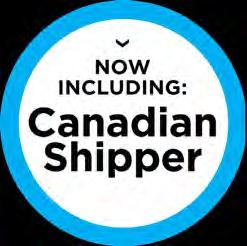
Keep “Your inside Track to Canada’s Supply Chain” Visit InsideLogistics.ca to SUBSCRIBE to the e-newsletter. Delivered every Tuesday and Friday. E-news CANAD A ’S SUPPLY CHAIN MA GAZINE
TRADING WITH INDIA
Closer ties developing through air services agreement
THE SIGNING OF a new air services agreement between Canada and India gives us the opportunity to examine our relationship with this regional power, a country that will surpass China to become the world’s most populous country next year.
A ccording to the United Nations, the world’s population reached eight billion in mid-November, just 11 years after it passed seven billion, highlighting the accelerated growth of the last few decades, and raising concerns about food scarcity around the world. According to the World Food Program, a United Nations agency that provides food assistance globally, since 2019 the number of people facing significant food insecurity has increased from 135 million to 345 million, not taking into account the consequences of Russia’s invasion of Ukraine. India is therefore not just an important trading partner for us, but may soon be at the forefront of a global food crisis.
The expanded air transport agreement recently signed allows designated airlines, namely Air Canada and Air India, to operate unlimited flights between our two countries. The previous agreement, originally reached in 1982 and expanded in 2011, limited each country to 35 flights per week.
The agreement gives Canadian airlines access to Bangalore, Chennai, Delhi, Hyderabad, Kolkata and Mumbai, and Indian airlines get access to Toronto, Montreal, Edmonton and Vancouver, with two additional points to be selected by India. Other cities in both countries can only be served indirectly through code-sharing services. Traffic rights for all-cargo services were already unrestricted.
What is surprising is that the deal comes at a time when international travel is far from pre-pandemic levels. The latest IATA statistics reveal that international air travel had only reached 69.9 percent of 2019 levels in September. Airfreight is doing better, as international air cargo stood at just 3.6 percent below 2019.
One explanation could be the increase in the number of Indian students coming to study in Canada. According to Immigration, Refugees and Citizenship Canada (IRCC),
CHRISTIAN SIVIÈRE
runs Solimpex, and is an international trade consultant and lecturer. christian.siviere@videotron.ca

out of a total of 23,950 study permits issued in the first two month of 2022, more than half were issued to students from India. In British Columbia, there are more than 143,000 international students, and India ranks as the top source country. Studying in Canada is a very practical way to land permanent residency after graduating. And India has been a big contributor to Canadian immigration: according to IRCC, 25 percent of new permanent residents in 2019 were from India.
Two-way merchandise trade between Canada and India stood at $10.1 billion in 2019 but decreased to $8.7 billion in 2020, due to the pandemic.
The top Canadian exports to India are mineral fuels, pulses, wood pulp, precious metals and paper and paperboard. The top Canadian imports from India were jewelry and precious stones, pharmaceuticals, organic chemicals, machinery and textiles. Last year, India ranked 13th as Canada’s source of imports, while Canada came 30th as a supplier to India.
Every now and then, we hear from Ottawa about Free Trade Agreement discussions with India. We concluded a fourth round of negotiations on an Early Progress Trade Agreement (EPTA) in September, a first step before moving to full-fledged FTA negotiations, which is what Canada hopes to achieve.
Historically though, India has been a rather protectionist country, where rules can change overnight or higher tariffs are imposed when the government decides to protect certain industries. For example, in February, the Indian government increased tariffs on 31 product categories including cotton, palm oil, ethanol, solar panels and walnuts.

Canadian pulses exporters know the market very well, as India used to be Canada’s biggest customer for lentils and other pulse crops. But as India developed its own production, it started imposing 33 percent tariffs on lentils and 50 percent on peas in 2017, to protect its own producers. A few years ago, Indian Customs decided to change the HS code for incoming solar panels overnight so it could tax imports and protect the emerging Indian solar panels industry.
Another factor is that supply chains are stretched. There is a push to bring some manufacturing closer to home and develop regional supply chains. Reshoring and nearshoring have become post-pandemic buzzwords, but India is a bit far away to fit that model.
A new buzzword was recently introduced by our deputy prime minister. “Friend-shoring” means favouring trade with countries that share our values of democracy, freedom of expression, equality, non-discrimination and the rule of law. This is a noble cause, although it may be difficult to put in practice.
It was mostly aimed at excluding Russia and the countries that support its invasion of Ukraine, namely China. But India is in that gang as well. It has not applied sanctions, and actually benefits from the energy and commodity crisis caused by Russia. India’s imports from Russia broke records this year, mainly thanks to Indian purchases of fertilizers and oil bought below world prices, helping Russia by-pass Western sanctions.
Politically, Indian Prime Minister Narendra Modi’s Hindu nationalist government has embarked on the Hinduization of India, to the detriment of Muslim, Christian and Kashmiri minorities, who are treated like second-class citizens. These are not exactly Canadian values, and take “friend-shoring” with India off the table.
insidelogistics.ca 29 T R ADE UP D A T E
PREVENTING WORKPLACE CONCUSSIONS
Keep your warehouse workers safe with these best practices
MILD TRAUMATIC HEAD injuries, also known as concussions, are on the rise in Ontario workplaces. Caused by blows or jolts to the head, concussions can have complex and serious consequences for workers, including physical and cognitive impairment, headaches, blurred vision, depression, and sleep disorders. Symptoms can last a long time, making recovery and return to work difficult.
Sometimes, concussions can be deadly. In a case in Ontario, a worker in a warehouse tripped over an empty pallet. The worker complained about an injury to the head and called in sick the next day. They passed away in the hospital two weeks after the incident. The employer was fined $60,000 for violating Ontario’s health and safety legal requirements by not keeping the floor clear of obstructions and hazards.
Warehouse settings may be particularly problematic when it comes to head injuries because of crowded work areas, high demand, the constant movement of people and machinery, excessive inventory, lack of storage areas, and more. The direct causes of head impacts include: Slips, trips, and falls — which can occur when walkways and work areas are obstructed by materials when surfaces are wet or slippery Falls from heights — for instance, when a worker on a ladder falls while removing product off a high shelf and suffers a head injury Falling objects — when merchandise or products falls on workers from overhead shelving or racking
Duty to accommodate
Concussions have been called invisible injuries. The manager of someone with a concussion can’t see the debilitating headache, the brain fog, or the intense pain from loud noise and bright light.
While the injury may be invisible, the consequences are not. According to a recent Canadian study, one in six people reported changing their work habits to manage persistent concussion symptoms at work, and one in five reported struggling
NORM KR AMER, is a Canadian Registered Safety Professional with over 25 years of experience. Norm provides health and safety consulting services for Workplace Safety & Prevention Services (WSPS) as a Warehouse Specialist in the GTA region.
workers from hazards, including hazards related to concussion.
Best practices
Follow these best practices for preventing and managing concussions.
1. Eliminate or control slip, trip and fall hazards. Include policies and protocols in your company’s health and safety program. Measures include having dedicated places to store inventory and empty pallets rather than using walkways or aisleways, and developing and enforcing good housekeeping practices for regularly removing clutter, spills, ice and snow from walkways and loading docks.
2. Address hazards related to falls from heights and falling objects. Train employees on ladder safety; ensure loads are secure and pallets are supported evenly across both beams to ensure load stability.
TONI VOLPATO, is a Canadian Registered Safety Professional with over 25 years of experience. Tony, (CIH) provides consulting services as a specialized consultant in occupational hygiene for WSPS.

to meet their employment demands over months or years. “Some may reduce work hours or exit the workforce entirely,” the authors wrote.
Using a return to work protocol specific to concussion allows employees to heal as quickly as possible, with the least disruption for the workplace. Human rights laws across Canada recognize concussion as a disability and require employers to accommodate workers by adjusting work conditions to enable the employee to continue working.
Preventing concussions
Taking action to eliminate and control hazards that can lead to concussions will help avert needless suffering for workers, and protect your workplaces from related costs and liability. Employers across Canada have a duty under health and safety laws to take every reasonable precaution to protect
3. Ensure employees wear appropriate footwear. Non-slip footwear with an appropriate tread can help minimize the risk of slips and falls on slippery surfaces when used in conjunction with good housekeeping.
4. Encourage workers to report unsafe conditions to the nearest supervisor.
5. Provide concussion awareness education to supervisors and workers. Include causes, effects and prevention.
6. Act quickly if an employee sustains an impact to the head. It’s important to seek professional treatment right away. A qualified health provider with specialized training in concussion management and a gradual return to work can help the worker resume work safely and avoid prolonged symptoms and absences.

7. Develop a return-to-work protocol specific for concussions. Communicate the protocol to the workforce.
8. Train supervisors on the return to work protocol. Supervisors carry the bulk of the responsibility when it comes to integrating disabled workers back into the workforce. They need a clear understanding of accommodation requirements and their duties.
30 INSIDE Logistics DECEMBER 20 22
SAFE T Y FIRS T
supply chains explored

With over 900 of the world’s leading manufacturing and supply chain solution providers under one roof, you can see firsthand what the future holds – and find the tools you need to shockproof your operations and move your business forward. From hands-on demonstrations to 150 educational seminars and four exciting keynote speeches, ProMat 2023 gives you free access to an unrivaled supply chain experience.
Learn more and register at promatshow.com.
MARCH 20-23, 2023 MCCORMICK PLACE CHICAGO, IL promatshow.com




GET CLOSER TO YOUR CUSTOMERS. Call us today. | 1.888.668.4626 | cn.ca You have one thing on your mind. Getting your cargo where it needs to go. As a leading North American transportation and logistics provider we work closely with our supply chain partners to help our customers stay competitive in the global marketplace. With an extended North American reach, a strategic network of transload facilities and direct access to major distribution centers and ports on three coasts, you can trust us to deliver to the people who matter most - your customers.






























































 Ara Asokan, CCLP Scarborough, ON Solange Bamoum, CCLP Lachine, QC
Rachel Arseneau, CCLP Mississauga, ON
Nothing says professional logistics expert like CCLP CITT is proud to present the CITT-Certified Logistics Professionals who earned their CCLP designations between September 2021 & October 2022. Congratulations to the more than 100 dedicated supply chain logistics professionals who now join the ranks of the industry’s elite.
Cole Brumwell, CCLP Mississauga, ON Matthieu Casey, CCLP Dorval, QC
Ruby Cozart, CCLP Chaplin, SK
Shady El-Orbany, CCLP Calgary, AB
Maria Luisa Espinola, CCLP Toronto, ON Katherine Evans, CCLP Cambridge, ON Adebayo Fadehan, CCLP Winnipeg, MB
Dan Granic, CCLP Mississauga, ON
James Homolka, CCLP Mississauga, ON Kobina Impraim, CCLP Milton, ON
Alan Johnstone, CCLP Toronto, ON Silvio Kusakawa, CCLP Toronto, ON
Kersti Lee, CCLP Saint John, NB
Thomas Lemierzewicz, CCLP, Oakville, ON
Clay Dowling, CCLP Saskatoon, SK
William Li, CCLP Surrey, BC
Brett Lyon, CCLP Winnipeg, MB
Chad MacGillivray, CCLP Markham, ON Karolina Mazurowski, CCLP, Surrey, BC
Glen Mol, CCLP Mississauga, ON
Patrick Nebo, CCLP Lagos
Ara Asokan, CCLP Scarborough, ON Solange Bamoum, CCLP Lachine, QC
Rachel Arseneau, CCLP Mississauga, ON
Nothing says professional logistics expert like CCLP CITT is proud to present the CITT-Certified Logistics Professionals who earned their CCLP designations between September 2021 & October 2022. Congratulations to the more than 100 dedicated supply chain logistics professionals who now join the ranks of the industry’s elite.
Cole Brumwell, CCLP Mississauga, ON Matthieu Casey, CCLP Dorval, QC
Ruby Cozart, CCLP Chaplin, SK
Shady El-Orbany, CCLP Calgary, AB
Maria Luisa Espinola, CCLP Toronto, ON Katherine Evans, CCLP Cambridge, ON Adebayo Fadehan, CCLP Winnipeg, MB
Dan Granic, CCLP Mississauga, ON
James Homolka, CCLP Mississauga, ON Kobina Impraim, CCLP Milton, ON
Alan Johnstone, CCLP Toronto, ON Silvio Kusakawa, CCLP Toronto, ON
Kersti Lee, CCLP Saint John, NB
Thomas Lemierzewicz, CCLP, Oakville, ON
Clay Dowling, CCLP Saskatoon, SK
William Li, CCLP Surrey, BC
Brett Lyon, CCLP Winnipeg, MB
Chad MacGillivray, CCLP Markham, ON Karolina Mazurowski, CCLP, Surrey, BC
Glen Mol, CCLP Mississauga, ON
Patrick Nebo, CCLP Lagos















 Akinwale Ojelade, CCLP Hamilton, ON Abdulwasiu Okutade, CCLP, Toronto, ON
Ayodeji Orija, CCLP Ottawa, ON
Rohit Pandey, CCLP Scarborough, ON
Andrew Penwarden, CCLP, Irvine, ON John Runcie, CCLP Saint John, NB
Dan Schmidt, CCLP Winnipeg, MB Simarjot Shah, CCLP Brampton, ON
Parwinder Singh, CCLP, Vaughan, ON
Jonathan Solomon, CCLP, Winnipeg, MB Tatiana Strelnikova, CCLP Mississauga, ON Onuoha Ukeh, CCLP Ikeja, Lagos
Erik Valiquette, CCLP Montreal, QC Aleah Voutour, CCLP Saint John, NB
Vincent Wahba, CCLP Etobicoke, ON
Melissa Xaikosy, CCLP Winnipeg, MB
Photos of the following new CITT-Certified Logistics Professionals were not available:
Akinwale Ojelade, CCLP Hamilton, ON Abdulwasiu Okutade, CCLP, Toronto, ON
Ayodeji Orija, CCLP Ottawa, ON
Rohit Pandey, CCLP Scarborough, ON
Andrew Penwarden, CCLP, Irvine, ON John Runcie, CCLP Saint John, NB
Dan Schmidt, CCLP Winnipeg, MB Simarjot Shah, CCLP Brampton, ON
Parwinder Singh, CCLP, Vaughan, ON
Jonathan Solomon, CCLP, Winnipeg, MB Tatiana Strelnikova, CCLP Mississauga, ON Onuoha Ukeh, CCLP Ikeja, Lagos
Erik Valiquette, CCLP Montreal, QC Aleah Voutour, CCLP Saint John, NB
Vincent Wahba, CCLP Etobicoke, ON
Melissa Xaikosy, CCLP Winnipeg, MB
Photos of the following new CITT-Certified Logistics Professionals were not available:























